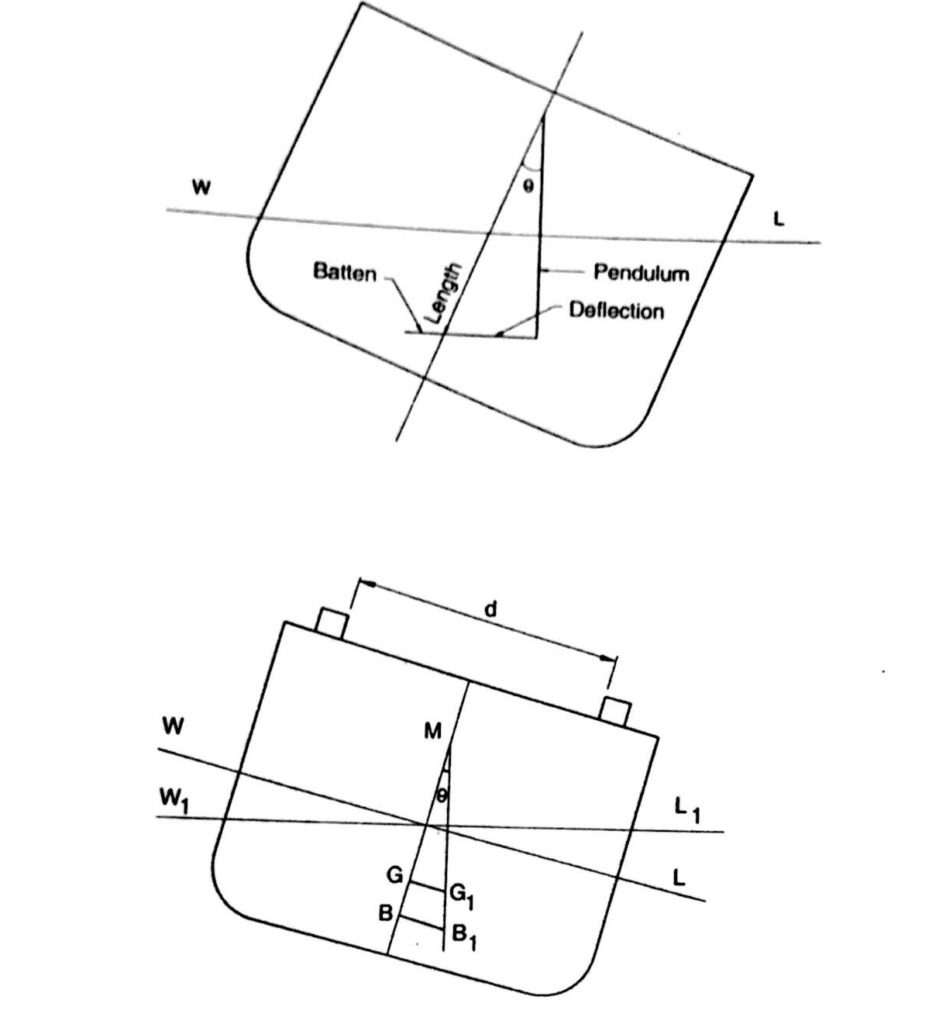Why the vessel has to be inclined ???
To obtain the metacentric height it is necessary to determine the position of the centre of gravity `G’. This calculation consists of two parts.
a) The first is the finding of the height of the metacentre ‘M’ above the keel ‘K’. This is purely geometrical depending only on the form of the ship.
The second is the height of the centre of gravity above ‘K’ and this depends on the lightweight of the ship hull including disposition of machinery and equipment, water or ballast, if carried and allowances for free surfaces.
Why Inclining Experiment
Ship’s officers are primarily concerned with the value of GM in any particular condition. The naval architect on the other hand is concerned about the position of the centre of gravity in the light ship or light mass condition, since it is the basis for calculations of stability for different condition of loading.
To determine the position of the vertical centre of gravity an inclining experiment is carried out. The immediate purpose of the experiment is to determine the metacentric height. The ultimate purpose is to obtain the height of the centre of gravity for a definite condition of the ship – the Light Condition.
Process for Inclining the Ship
A small known mass is moved transversely on the deck through a known distance. The resultant angle of heel is measured either by means of two pendulums or by an instrument called a stabilograph, which records directly the movement of the ship in degrees. Where pendulums are used, they should be as long as possible supported by a fine wire with a heavy bob weight. The deflection of the pendulum is measured against a horizontal batten as shown in figure later.
In the experiment, a mass (w) is moved transversely across the deck through a known distance (d). As the mass w is moved across the deck, the centre of gravity of the ship moves from G to G₁ such that:
w d = GGI
where Δ = displacement of ship.
At the same time, the ship will be inclined through some angle Ɵ and will be in a position of stable equilibrium.
The centre of buoyancy B originally under G will have moved to B₁ to be in the same vertical line as G₁. GG₁ is parallel to the movement of w and hence the angle G₁GM is a right angle and
GG₁ = GM tan Ɵ
w x d= Δ xGM tan Ɵ
or GM = (w x d) / Δ tan Ɵ
also tan Ɵ = GG₁ I GM = deflection of pendulum I length of pendulum
During the experiment, it is necessary to make several shifts of mass from side to side, take readings at each shift from the plumb lines and then use mean values.

Precautions to be taken during Inclining experiment.
The principle underlying the inclining experiment is simple but the carrying out of the experiment requires careful attention to ensure a reliable result. Since all subsequent stability calculations are based upon the position of the centre of gravity determined by this experiment it is essential that all the factors, which affect its accuracy, be considered.
- A calm day should be chosen.
- It is desirable that the experiment be made when the ship is nearly, if not, completed.
- A list should be made of loads to be added, items to be taken off and items on board that are to be shifted along with their vertical and longitudinal positions of centre of gravity.
- The ship must be floating freely. All mooring wires should be slack and shore gangways removed.
- All tanks should be empty or pressed full.
- All workmen, other than those engaged in experiment, should be sent ashore. Those on board should remain as nearly as possible in a constant position while readings are being taken.
- All loose items such as derricks, boats, etc. should be secured, in their sia going condition.
- Chalk lines on the deck should define the position of the inclining masses.
- At least two plumb lines should be used one forward and one aft. A white wood batten should be placed so that its edge is close to the swing of the pendulum. If each successive position of swing is marked and numbered it is possible to check all the figures at the end of the experiment. A heavy plumb bob at the end of the line is conducive to steadiness and it is usual to have the bob swinging in the container of water in order to damp the oscillations. The pendulum readings could be used as a check on a stabilograph.
- The draughts must be carefully measured. The draught amidships should also be taken by measuring with a batten the distance from the Plimsoll mark on each side to the water level. The hog or sag of the vessel is thus determined, and also the initial list, if any. The density of the water in which the ship is floating should be determined by a hydrometer.